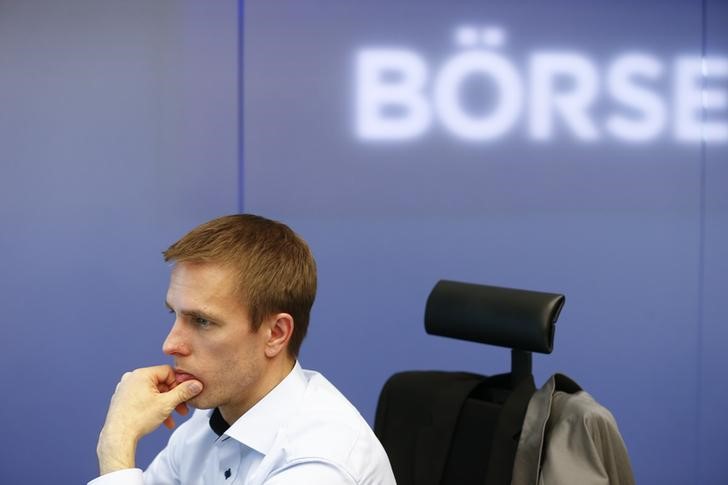* European stocks up, Asia & Gulf down
* Iran sanction lift hits oil
* U.S. markets closed for holiday
By Jamie McGeever
LONDON, Jan 18 (Reuters) - Many stock markets around the world and oil prices slumped to multi-year lows on Monday amid persistent worries over global growth, although European stocks offered a chink of light in the gloom, staging an early bounce following last week's sell-off.
Middle Eastern stocks plunged overnight, catching up with the fall across global bourses on Friday, while the prospect of a jump in Iranian crude exports after the lifting of sanctions against the country weighed heavily on oil.
With U.S. markets closed for the Martin Luther King Day holiday, any hope equity bulls have for a fight back from the worst start to a year ever rest with Europe, where the main indices have lost as much as 10 percent in just two weeks.
In early trading on Monday the FTSEuroFirst 300 index of leading shares was up 0.7 percent .FTEU3 , Germany's DAX was up 0.6 percent .GDAXI , France's CAC 40 was up 0.4 percent .FCHI and Britain's FTSE 100 was up 0.3 percent .FTSE .
"We have seen a positive open in Europe, though that looks likely to be put to the test if Asia's market performance is any guide," said Michael Hewson, chief market analyst at CMC Markets in London.
"It's encouraging that, so far at least, European markets are shrugging off Asia's losses," he said.
Gains at mobile telecoms gear marker Ericsson (ST:ERICAs) ERICb.ST and luxury goods group LVMH LVMH.PA lifted the FTSEuroFirst off its 1-year low struck on Friday.
There was less to cheer about in Asia, however. MSCI's broadest index of Asia-Pacific shares outside Japan .MIAPJ0000PUS fell to its lowest since October 2011 and was last down 0.3 percent.
Japan's Nikkei .N225 tumbled as much as 2.8 percent to a one-year low before closing 1.1 percent lower. It has lost 20 percent from its peak hit in June, meeting a common definition of a bear market.
MSCI's emerging stock index .MSCIEF dropped to 6-1/2-year low on Monday, and was last down 0.3 percent on the day.
The volatile Shanghai Composite index .SSEC initially pierced through intraday lows last seen in August before paring the losses and closed up 0.4 percent. It was still down nearly 18 percent this month.
On Wall Street the S&P 500 .SPX hit a 15-month low on Friday, ahead of Monday's market holiday.
IRAN OIL EXPORTS EYED
In oil markets, Brent crude fell below $28 a barrel LCOc1 for the first time since December 2003 after international sanctions against Iran were lifted over the weekend, allowing Tehran to return to an already over-supplied oil market.
U.S. crude also slumped to 12-year lows CLc1 , intensifying the pressure on U.S. energy sector "junk" bonds. The Merrill Lynch energy high yield debt index tumbled to its lowest in over five years on Friday, posting its biggest weekly fall since October 2008 and the second biggest fall ever .MERH0EN .
"The lifting of key sanctions should allow it (Iran) to increase crude exports this year by at least 500,000 barrels a day on average, putting further downward pressure on oil prices in the near term," Barclays (L:BARC) analysts said in a note on Monday.
Analysts at JP Morgan said that oil-producing countries will need to sell large quantities of stocks and bonds this year to cover the shortfall in their budgets resulting from the slump in oil prices.
They estimate sales of $110 billion bonds this year, up from $45 billion last year, and $75 billion of equities compared with $10 billion last year.
In currency markets the Chinese yuan rose 0.3 percent CNH= in the offshore trade to 6.5966 per dollar, as Chinese authorities continued to stamp down speculative yuan selling.
China will start implementing a reserve requirement ratio (RRR) on some banks involved in the offshore yuan market, the People's Bank of China (PBOC) said on Monday, in what appears to be its latest attempt to stem speculation in the currency.
The safe-haven yen gave up some of its gains after having risen to a five-month high of 116.51 to the dollar JPY= on Friday. It last stood at 117.31. The euro also edged down against the dollar to $1.0891 EUR= .
The U.S. dollar has struggled to gain much ground since the Federal Reserve's historic interest rate rise a month ago, as the latest data added to indications that U.S. economic growth braked sharply in the fourth quarter.
Following that data, the Atlanta Federal Reserve's closely-watched GDPNow forecast model showed the U.S. economy is on track to grow 0.6 percent in the fourth quarter, slowing sharply from 2.0 percent growth in the third quarter.
Investors further cut back their Fed rate hike expectations, with short-term interest rate futures 0#FF: pricing in only one rate hike by the end of year, compared with two hikes priced in at the start of year.
In European bond trading, yields rose by around 1-3 basis points across "core" markets such as Germany and "peripheral" markets like Spain.
